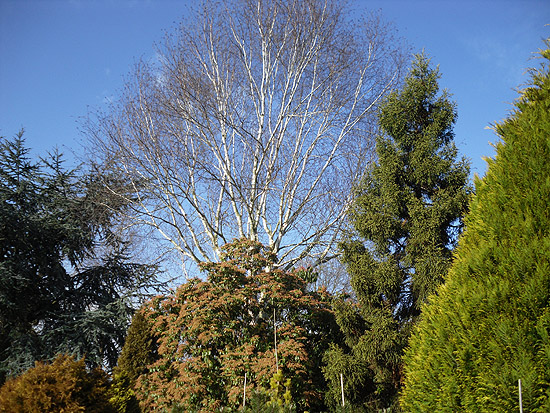
| HOME |
| NERVE |
| REVIEWS |
| ARCHIVE |
| EVENTS |
| LINKS |
| ABOUT US |
| CONTRIBUTORS |
| BACK ISSUES |
| CONTACT US |
 |
Fireweed*
By Sandra
Gibson
Photograph by Geoff Edwards
Time for a Tree
December 2012
In December many people bring a tree into their living space: usually a conifer with or without roots, or a facsimile, either bearing some resemblance to the real thing, or making only a slender reference to the original. White trees with in-built black baubles; minimalist two dimensional trees in tubular neon; ‘trees’ that once displayed magazines in newsagents; we are all aware of the variety possible within the Christmas Tree phenomenon. Leaving aside the cultural and religious motives for this activity, here is a yearly opportunity for people to be creative. In our household there exists a division between the naturally-resourced-and-aesthetically-tasteful-ornaments-on-a-white-branch sector and the neo-gothic/baroque/kitsch-let’s-challenge-the-National-Grid-let’s-fill-every-nook-and-cranny-with-LED-lighted-Virgin-Marys-and-Santas-and-snowmen sector. Guess who wins.
But I have noticed, this year and last year, a decrease in the number of illuminated trees in windows and gardens - a reflection of austere times and perhaps a sign that people are developing a more thoughtful attitude to energy consumption.
Let’s spare a thought for the tree itself, beneath all its naff finery, away from our frenetic interference. In winter, the green of our conifers becomes prominent because the diverting colours of the flowering months have gone. Our parks contain these silent, dignified sentinels, these statues of endurance offering a rainbow of greens: grey green, moss green, olive green, blue green; some - the yellow varieties - have needles of sunshine. The promise of spring. Pruned to taper at the top, they point at the sky; rounded and sculpted, they resemble chessmen in a patient game. And the sharp fresh scent of pine needles is so redolent of the festive season, so earth-clean.
Our deciduous trees have their own beauty: the birch denuded of its wind-twinkling leaves, its network of outer branches reddened to a brown-pink by sunlight, stands silver-proud against a sky of ice-blue. Small round birds, winter-fluffed against the cold, bob from branch to branch, rubbing their beaks against the bark.
And it is good to watch the birds, seemingly immune to the prickles, eating red and orange pyracantha berries, or feasting on the glace cherry lookalike honeysuckle fruit; it reminds us that a tree’s adornment is part of its life-giving qualities in winter.
This is surely a good cause for celebration.
To read other Fireweed columns click here
*Also known as Rose Bay Willow Herb, the prolific wild flower called Fireweed, five feet tall with spikes of magenta flowers, cheers the hearts of those whose cityscape has become a bomb site or whose buildings have been cleared by machine. The dormant seeds spring to life after destructive events such as forest or man-made fires, hence the name, Fireweed. This occasional column will celebrate the persistence of wildlife in urban conditions.